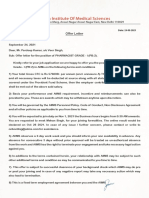0% found this document useful (0 votes)
13 views49 pagesLecture 01 Introduction and SDLC
The document outlines the course CSE-471 on System Analysis and Design, coordinated by Dr. Muhammad Iqbal Hossain at BRAC University. It covers key concepts such as the Systems Development Life Cycle (SDLC), the importance of systems analysis, and various methodologies including DevOps. Additionally, it highlights the roles and skills required for project teams in the context of system development.
Uploaded by
tazree41Copyright
© © All Rights Reserved
We take content rights seriously. If you suspect this is your content, claim it here.
Available Formats
Download as PDF, TXT or read online on Scribd
0% found this document useful (0 votes)
13 views49 pagesLecture 01 Introduction and SDLC
The document outlines the course CSE-471 on System Analysis and Design, coordinated by Dr. Muhammad Iqbal Hossain at BRAC University. It covers key concepts such as the Systems Development Life Cycle (SDLC), the importance of systems analysis, and various methodologies including DevOps. Additionally, it highlights the roles and skills required for project teams in the context of system development.
Uploaded by
tazree41Copyright
© © All Rights Reserved
We take content rights seriously. If you suspect this is your content, claim it here.
Available Formats
Download as PDF, TXT or read online on Scribd
/ 49























































































